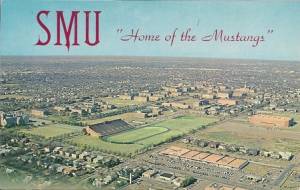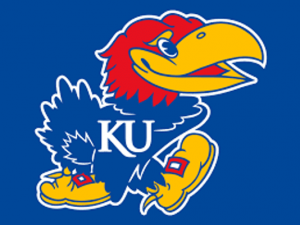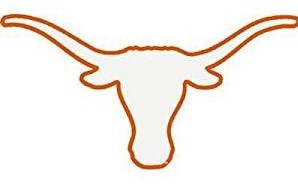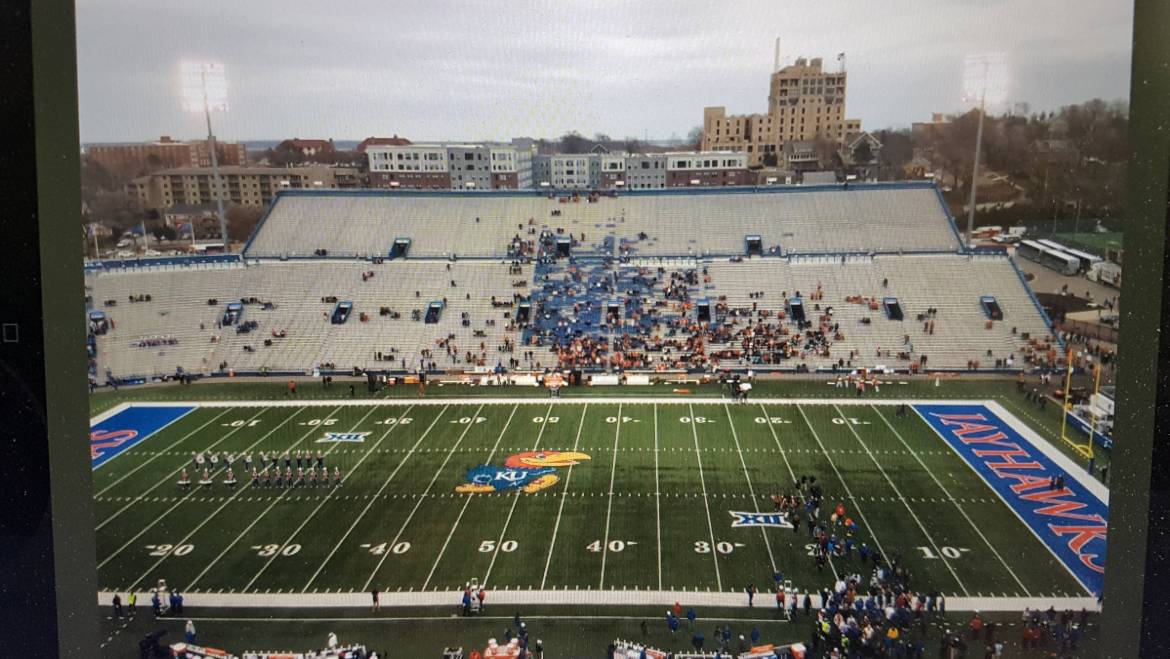In July 1990, the University of Arkansas—by which I mean former football coach and then-AD Frank Broyles—declared that it would leave the Southwest Conference, of which it had been a member for 76 years. The Razorbacks were going to the Southeastern Conference, a more stable and financially remunerative league. This was the beginning of the end for the SWC, half of which would join the Big 8 in 1996 to form the Big 12. (Texas A&M followed the Hogs to the SEC in 2012, not to mention other departures and additions.)
Razorbacks and Mustangs
Just four months after that long-rumored and -dreaded announcement, there was a game in Dallas. In the final week of the season, SMU hosted Arkansas. (You know, of course, that the Mustangs had been caught red-handed in a pay-for-play scheme that merited the “death penalty” from the NCAA for the 1987 season; perhaps  out of penance, the school’s administration decided to extend it through 1988. So for two years, SMU students, alumni and fans had no football. The 1989 season was, as anybody could have predicted, a hard one for the Ponies. They went 2-9 and were on the short end of scores like 49-3 [Baylor], 95-21 [Houston] and 59-6 [Notre Dame]. It was even worse in 1990—one win and 10 defeats.) To save money and to keep tighter control over the football program, the university’s administration decided that home games would be played on campus at Ownby Stadium. This quaint facility, built in 1926, was last the scene of an SMU football game when Doak Walker was strutting his stuff. It was small—23,000 seats—and hopelessly out of date. With a college football arms race going on and ever more money being poured into these arenas where supposedly amateur athletic contests were held, SMU had no choice but to move in the other direction. I felt a degree of sympathy for Forrest Gregg’s team. Every conference has a weak sister or two or three, but they should not be too weak. Coming back from the death penalty, the Ponies were just that. The entire program was subject to close oversight; no criminals (at least no convicts) were recruited, and guys actually had to go to class, write papers and make passing grades. No more $5,000 handshakes.
out of penance, the school’s administration decided to extend it through 1988. So for two years, SMU students, alumni and fans had no football. The 1989 season was, as anybody could have predicted, a hard one for the Ponies. They went 2-9 and were on the short end of scores like 49-3 [Baylor], 95-21 [Houston] and 59-6 [Notre Dame]. It was even worse in 1990—one win and 10 defeats.) To save money and to keep tighter control over the football program, the university’s administration decided that home games would be played on campus at Ownby Stadium. This quaint facility, built in 1926, was last the scene of an SMU football game when Doak Walker was strutting his stuff. It was small—23,000 seats—and hopelessly out of date. With a college football arms race going on and ever more money being poured into these arenas where supposedly amateur athletic contests were held, SMU had no choice but to move in the other direction. I felt a degree of sympathy for Forrest Gregg’s team. Every conference has a weak sister or two or three, but they should not be too weak. Coming back from the death penalty, the Ponies were just that. The entire program was subject to close oversight; no criminals (at least no convicts) were recruited, and guys actually had to go to class, write papers and make passing grades. No more $5,000 handshakes.
Arkansas prevailed, 42-29. But let the record show that the 1990 Razorbacks were nothing special either. They finished with a 3-8 record, their defeat of SMU being their only conference win of the year. Before kickoff, Broyles, UA’s “Boss Hog,” surveyed the scene and made disparaging comments. Only 17,100 fans were  there in that run-down but spruced-up stadium. He called it bush league, proof that he was right in leaving for the SEC.
there in that run-down but spruced-up stadium. He called it bush league, proof that he was right in leaving for the SEC.
Jayhawks and Longhorns
These sad events are brought to mind by Friday’s game between Kansas and Texas (Horns, 24-17) up in Lawrence. It was held at David Booth Kansas Memorial Stadium. If you are at all like me, you are wondering about the identity of Booth. He is a rich alum who sought to purchase immortality by donating $50 million for renovation of KU’s 98-year-old dual-purpose stadium. Let us not forget that the Kansas Relays, one of America’s premier collegiate track and field carnivals, is held there every spring. Booth’s donation is not chopped liver, but it won’t do much. Consider that Texas A&M spent almost half a billion dollars on a top-to-bottom rebuild of Kyle Field between 2013 and 2015. The Jayhawks (Ray Evans, Don Fambrough, Curtis McClinton, John Hadl, Bert Coan, Gale Sayers, John Riggins, Bobby Douglass, David Jaynes, Nolan Cromwell, Dana Stubblefield et al.) have never won a national title but they have some pigskin history, finishing in the top 10 thrice. Still, these are hard times in Lawrence. In none of the last nine seasons has KU won more than three games. They went 0-12 in 2015, and you can’t get much worse than that. It pains me to recall that the next year they beat UT in overtime, effectively ending Charlie Strong‘s tenure as coach.
Before going any further, I want to acknowledge that in terms of sports KU is primarily a basketball school. The Jayhawks won the NCAA tourney in 1952, 1988 and 2008, and were runners-up six times. Bill Self‘s team is currently ranked No. 1. But the fact remains—you have to be able to compete in King Football.
The 2018 Jayhawks–Longhorns tilt was played shortly after Les Miles signed a contract to be the new coach (replacing David Beaty). Miles, the “Mad Hatter,” has a nice pedigree, having won the 2007 national crown while at LSU, but his work is cut out for him. The players are not very good (no NFL draftees in 2016 or 2017), the stadium is small (50,071 seating  capacity), old and dilapidated, and worst of all—no one seems to care. With Kansas facing the 11th-ranked team in the nation (Texas), only 15,219 people (a substantial number of whom were in orange) showed up. Whether that includes the cheerleaders and popcorn vendors, I am not sure. The weather—cloudy, 52 degrees and a wind of 15 miles per hour—was not unpleasant. Photos of the stands, with large swaths completely empty, were startling. Lots of high school football games in the Lone Star State draw more fans. I wonder what UT coach Tom Herman and athletic director Chris Conte thought at the 11 o’clock kickoff. It is probably along the line of Frank Broyles’ snide comments about SMU and Ownby Stadium 28 years earlier. The Mustangs, then still reeking of the death penalty, had an excuse. Today’s Jayhawks have none.
capacity), old and dilapidated, and worst of all—no one seems to care. With Kansas facing the 11th-ranked team in the nation (Texas), only 15,219 people (a substantial number of whom were in orange) showed up. Whether that includes the cheerleaders and popcorn vendors, I am not sure. The weather—cloudy, 52 degrees and a wind of 15 miles per hour—was not unpleasant. Photos of the stands, with large swaths completely empty, were startling. Lots of high school football games in the Lone Star State draw more fans. I wonder what UT coach Tom Herman and athletic director Chris Conte thought at the 11 o’clock kickoff. It is probably along the line of Frank Broyles’ snide comments about SMU and Ownby Stadium 28 years earlier. The Mustangs, then still reeking of the death penalty, had an excuse. Today’s Jayhawks have none.


1 Comment
Richard:
Great content – I remember SMU getting the death penalty like it was yesterday.
Thank you, again, for your article on Ring – it is very much appreciated.
My wife and I are in semi-retirement in Tucson and teaching the basics of golf and tennis to elementary school children. It’s about two hours every weekeday afternoon.
Best wishes,
Rex
Add Comment